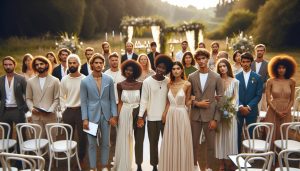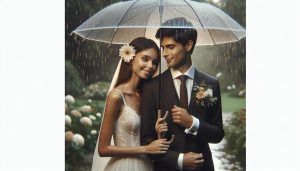When it comes to purchasing wedding rings, many couples find themselves navigating a blend of tradition and modern expectations. Did you know that the act of buying wedding rings has evolved significantly over the years? While historically it was often the sole responsibility of one partner, today’s couples are increasingly embracing shared decisions. Understanding who buys the wedding rings is more than just a logistical question; it reflects your values, relationship dynamics, and partnership. Exploring contemporary etiquette can help ease the stress of this important purchase, ensuring it aligns with your unique love story. Whether you lean towards timeless traditions or modern approaches, this guide will illuminate the key considerations and etiquette rules guiding today’s wedding ring buying process. Keep reading to discover how to make this exciting decision together, blending personal preferences with meaningful traditions.
Who Traditionally Buys the Wedding Rings?
Traditionally, the responsibility of purchasing wedding rings has often been assigned to the groom. This custom aligns with the practice of the groom proposing with an engagement ring, signifying a commitment and intention to marry. While etiquette once dictated that each partner would pay for the other’s wedding band, this expectation has evolved significantly over the years. Each couple now has the freedom to determine what feels right for them, blending modern values with time-honored traditions.
As societal norms shift, many couples today prefer to approach ring purchasing collaboratively or even equally. This change reflects broader movements towards partnership and shared responsibilities in relationships. Couples often engage in discussions about their preferences and budget considerations for rings, considering personal taste and financial comfort. It’s not uncommon to see couples shopping for wedding bands together, allowing both partners a say in the choice and style, which fosters a more inclusive experience.
Moreover, cultural variations add another layer to the tradition of who buys wedding rings. In some cultures, specific families may carry the financial burden of purchasing the rings, while in others, friends or extended family might contribute. Understanding these differences is essential as they can provide insight into various wedding traditions and expectations based on cultural backgrounds.
Ultimately, the decision of who buys the wedding rings is steeped in personal choice and circumstance. Engaging in open and honest conversations about financial commitments and ring preferences can help navigate these decisions, ensuring that the final choices resonate with both partners and reflect their unique love story.
Modern Perspectives on Ring Purchasing
In today’s world, the approach to purchasing wedding rings reflects evolving relationship dynamics, showcasing a shift towards shared responsibility and partnership. Couples increasingly seek to navigate this important milestone together, symbolizing their commitment to building a life side by side. This modern perspective encourages a dialogue about preferences, financial contributions, and individual styles, leading to a more meaningful experience as they choose rings that resonate with both partners.
A significant trend in ring purchasing is the collaborative shopping experience. Many couples are opting to explore options together, allowing them to express their tastes and values while fostering inclusiveness. This approach not only enhances the personalization of the rings but also strengthens the bond between partners. Couples often find that discussing their desires early on helps align their visions and budget, transforming what was once a solo endeavor into a shared journey filled with excitement.
Modern etiquette also embraces flexibility. Rather than adhering strictly to traditional roles, many couples are considering alternatives that suit their circumstances. For instance, some may agree to split the cost of both engagement and wedding rings, or they might choose to invest in rings that reflect their unique love story rather than conforming to societal expectations. Additionally, it’s not uncommon for partners to consider custom designs that better represent their relationship, making the rings even more significant as symbols of their commitment.
While cultural considerations remain important, the key takeaway is that modern couples are prioritizing communication and mutual agreement in ring purchasing. By engaging in open discussions about preferences, values, and finances, partners can ensure that their choices reflect both individual desires and their shared future. This inclusive approach transforms the ring-buying process into a celebratory event, strengthening their connection and marking the beautiful journey they are embarking upon together.
Key Factors Influencing Ring Buyers
Choosing wedding rings is an exciting yet complex process that involves a multitude of factors. One of the most significant influences on who buys wedding rings is the evolving perception of gender roles in relationships. Traditionally, cultural norms dictated that the man would purchase both the engagement and wedding rings, often placing a heavy financial expectation on this single individual. However, as relationships have shifted toward more egalitarian principles, many couples are embracing a more collaborative approach.
Consequently, couples are increasingly considering their preferences when determining who should pay for the rings. Communicating openly about financial contributions can foster a sense of partnership and shared responsibility. Many couples now agree to split the costs or discuss their budgets upfront, ensuring both partners feel comfortable and valued in the buying process. This not only relieves financial pressure but also deepens the emotional connection as they explore options together.
Cultural Differences also play a crucial role in guiding decisions about ring purchases. From elaborate ceremonies with multi-generational traditions to minimalist approaches, each culture brings its unique practices to the forefront. For example, in some cultures, families may provide financial support for the rings, while in others, the couple bears the entire cost. Understanding these variations can help couples navigate their decisions with sensitivity and respect for their backgrounds.
Lastly, personal preferences and symbolism heavily influence the selection of wedding rings. Some couples might choose classic designs that echo family heirlooms, while others may opt for personalized pieces that reflect their unique love story. The emotional significance behind the ring can dictate not just style, but who feels most comfortable purchasing it. By weighing these factors thoughtfully, couples can craft a meaningful experience that honors their shared journey, enhancing the excitement surrounding their upcoming nuptials.
The Role of Couples in Wedding Ring Decisions
The journey of selecting wedding rings is uniquely personal and a valuable opportunity for couples to deepen their connection during the wedding planning process. Unlike the conventional expectation where one partner-typically the groom-takes the lead in purchasing the rings, modern couples often embrace a more inclusive approach. This evolution reflects a broader shift in relationship dynamics, where collaboration and shared decision-making are prioritized. By involving both partners in the ring selection process, couples not only enhance the experience but also ensure that the rings carry shared meaning and significance.
One of the key benefits of making ring decisions together is the ability to blend personal tastes. Each partner brings individual preferences to the table, creating a more diverse selection that resonates with both personalities. For instance, one may prefer classic styles influenced by family heritage, while the other might be drawn to more contemporary designs. Engaging in discussions about features-such as metal types, stone choices, and design preferences-allows couples to merge their visions, resulting in rings that are a true reflection of their shared journey.
Moreover, discussing budget openly is a defining aspect of this process. Couples can navigate financial considerations collaboratively, setting a spending limit that reflects both their financial reality and the value they place on their rings. This can lead to practical decisions, such as prioritizing certain features over others or exploring alternative gemstones that maintain the rings’ aesthetic while being more budget-friendly. For instance, lab-grown diamonds or other gemstones can offer a stunning visual impact without the significant price tag, allowing couples to express their commitment without financial strain.
Lastly, selecting wedding rings together can bolster emotional bonds and create lasting memories. The experience of visiting jewelers, trying on various styles, and finally choosing the rings serves as a celebratory milestone in their engagement. It creates an opportunity for the couple to envision their future together, reinforcing the symbolism that wedding rings represent. By valuing this shared experience, couples not only emerge with beautiful symbols of their commitment but also strengthen the foundation of their relationship as they prepare for a life together.
Ultimately, is marked by increased partnership and mutual respect, reflecting modern values and individual stories woven into the fabric of their love.
Cultural Variations in Ring Buying Traditions
The traditions surrounding who buys wedding rings can vary significantly from one culture to another, reflecting deep-seated societal norms and values. In many Western cultures, the groom typically purchases the engagement ring, while both partners often share the responsibility of selecting wedding bands. However, this norm is not universal and has evolved over time. In some cultures, family involvement is crucial where parents or elders may contribute to or fully finance the rings, signifying their blessing and support for the marriage.
Distinct Cultural Practices
In countries like India, it’s common for the bride’s family to bear the cost of the wedding rings, emphasizing the exchange between families as much as between individuals. In contrast, Scandinavian countries observe a practice where couples might gift each other rings, symbolizing mutual commitment rather than a unilateral purchase. This reciprocal approach enhances the shared significance of the rings, allowing both partners to feel equally valued in the decision-making process.
Furthermore, in some Middle Eastern cultures, gold is a dominant symbol of love and wealth. The tradition may involve the groom presenting not just engagement rings but also a series of gold ornaments for the bride as part of the marriage contract. This reflects a cultural emphasis on prosperity and security, which intertwines with the value of the rings themselves.
Modern Adaptations
With the rising trend of gender equality, many couples today prefer a more inclusive and egalitarian approach to purchasing rings, regardless of cultural traditions. This modern perspective allows both partners to participate in the design and selection process, ensuring that the rings resonate with their shared values and aesthetic preferences. Couples are more frequently discussing financial contributions openly, allowing them to set budgets collaboratively and explore options that fit their financial situation without compromising on sentiment.
As societal norms continue to shift, the focus of wedding ring purchasing is increasingly on partnership rather than traditional buyership. This evolution encourages couples to celebrate not only their love through the rings but also their journey together, fostering deeper connections and mutual respect. Ultimately, regardless of who traditionally buys the wedding rings, the importance lies in the shared commitment they symbolize, transcending cultural practices and financial decisions alike.
Financial Considerations: Who Pays What?
The financial aspect of wedding rings can be a source of excitement and concern for many couples. As traditions evolve, so do the expectations around who pays for these significant symbols of love and commitment. Understanding the dynamics of financial responsibilities can help couples navigate this process with ease and agreement.
Traditionally, in many Western cultures, the groom is expected to purchase the engagement ring, while couples often share the costs of wedding bands. However, this is becoming less rigid, with many partners choosing a more modern approach. Open discussions about finances are encouraged-this might include weighing who has a larger budget, discussing expenditures from personal savings, or even jointly saving for these meaningful pieces. By aligning on financial contributions, couples can ensure that both partners feel valued and included in the wedding planning journey.
Financial Contributions and Considerations
When planning for wedding rings, it’s essential for couples to consider their entire wedding budget. Here are a few key factors to ponder:
- Your Overall Budget: Assess how much you’re allocating for the entire wedding. This will help you understand how much you can comfortably spend on rings.
- Shared vs Individual Expenses: Decide whether you want to share the costs entirely or if one partner is willing to cover a larger portion.
- Custom vs. Standard Rings: Custom-designed rings may carry higher costs. Consider your priorities-do you prefer uniqueness or cost-effectiveness?
- Financing Options: Some couples choose to finance their rings through loans or payment plans, which can ease the upfront cost burden.
Having an open conversation about these aspects can prevent misunderstandings and resentment later on.
Inclusivity in Ring Financial Decisions
Couples today are increasingly focusing on inclusivity and equality in financial decisions. This shift reflects broader societal changes and helps nurture a spirit of partnership. It’s not uncommon for both partners to contribute their preferences to the design and cost of the rings. For example, if one person prefers diamonds and the other opts for a unique gemstone, collaborating on the design can yield a result that both find meaningful.
In summary, approaching wedding ring purchases with a collaborative mindset can transform a potentially stressful topic into a celebration of partnership and commitment. By discussing financial factors openly, couples can create beautiful rings that symbolize not just their love but also their shared journey towards marriage.
Breaking Gender Norms in Wedding Ring Purchases
As wedding customs continue to evolve, so does the understanding of gender roles within the context of engagement and wedding ring purchases. In traditional scenarios, the expectation often fell upon the groom to select and purchase the engagement ring, leaving brides with the responsibility of choosing the wedding bands. However, contemporary couples are redefining these norms, opting for a more inclusive and personalized approach to ring buying that honors individual preferences over antiquated practices.
The rise of gender-neutral engagement rings exemplifies this shift. These rings prioritize personal expression over traditional gender norms, allowing both partners to select pieces that resonate with their unique styles and identities. Instead of adhering to “his” and “hers” rings, couples today explore options that reflect their shared values and contributions. This movement encourages open communication about preferences, allowing couples to collaborate on designs that signify their partnership rather than conforming to societal expectations.
Moreover, financial contributions are becoming increasingly gender-neutral, with couples jointly discussing budgets and preferences. Instead of a singular party bearing the financial burden, many couples are embracing a model where both contribute to the costs. This can involve sharing expenses, considering custom designs that may foster dual involvement, or navigating financing options together. Such practices not only promote equality but also enhance the emotional significance of the rings, as each partner’s input transforms them into representations of shared goals and love.
Ultimately, is about fostering a celebration of individuality and partnership. By encouraging open dialogue and exploration of preferences, couples can create rings that not only symbolize their commitment to each other but also reflect their journey through modern love, challenging the traditional paradigms that previously governed these cherished traditions.
The Impact of Engagement vs. Wedding Rings
The distinction between engagement rings and wedding rings plays a vital role in understanding modern purchasing decisions surrounding these cherished symbols of love. Traditionally, the engagement ring is a symbol of the proposal, typically given by the proposer to signify the intent to marry. This ring often features a prominent gem, like a diamond, representing commitment and emotional investment. On the other hand, wedding rings are exchanged during the ceremony, symbolizing the vows taken by each partner and their commitment to supporting and loving one another throughout their marriage.
However, as societal norms evolve, so does the significance of these rings. Couples today often choose to break away from traditional expectations, leading to interesting shifts in how rings are purchased and perceived. For example, in many instances, both partners may participate in selecting the engagement ring-either opting for a surprise or collaboratively choosing a design that truly reflects their unique relationship. The increasing popularity of non-diamond stones and custom designs showcases a growing desire for personal expression over convention.
When the wedding day arrives, the wedding bands serve to complement the engagement ring and are often simpler in design. Yet, the choice of wedding rings is increasingly becoming a joint decision, with couples exploring matching or personalized options that resonate with both partners’ tastes. This dual involvement not only enhances the emotional connection to the rings but also signifies equality in the partnership, demonstrating that both individuals have a voice in creating something meaningful for their union.
In managing the expectations and financial aspects of purchasing these rings, it’s essential for couples to engage in open discussions about their options. Establishing a budget that honors both partner’s preferences can help in making informed decisions that feel right. By approaching the selection of engagement and wedding rings as a collaborative effort, couples can foster a relationship that values shared experiences and mutual respect, ultimately creating a celebration that honors both their love story and personal journey.
Planning for Budget-Friendly Ring Options
Planning for wedding rings can be an exhilarating yet daunting task, particularly when considering the financial aspect. With the rise of personalization in weddings, many couples are now seeking ways to express their unique love story without incurring the heavy financial burden that often accompanies traditional ring purchases. The key to navigating this seemingly overwhelming landscape is to balance sentiment and budget while exploring various creative options that still honor the significance of marriage.
One of the most effective strategies is to set a clear budget early in the planning process. This involves having open discussions with your partner about what’s feasible and important to both of you. A budget allows for more intentional choices, so consider the following tips to keep costs in check while maximizing style and meaning:
- Explore Alternative Materials: Instead of traditional gold or platinum, consider other metals like titanium, stainless steel, or even rose gold. These materials can often provide a fresh aesthetic at a fraction of the cost.
- Opt for Lab-Grown Diamonds or Alternative Gemstones: Lab-grown diamonds offer ethical and environmental advantages without sacrificing beauty. Additionally, gemstones such as sapphires, emeralds, or moissanite can be stunning alternatives that can emphasize personal style.
- Buy from Online Retailers: Websites like James Allen and Blue Nile often provide high-quality options at competitive prices compared to brick-and-mortar stores. Shopping online also allows for a wider selection and the ability to easily compare prices.
- Customize Your Rings: Many jewelers offer customization options that don’t always come with the steep price tag of bespoke pieces. Opting for simpler designs can keep costs down while still providing a personal touch.
It’s also beneficial to take your time to research and read reviews before making a purchase. This diligence can lead to finding reputable retailers offering value without compromising quality. Ultimately, your wedding rings should reflect your shared journey-celebrate your love with pieces that resonate with your story while being mindful of your finances. With thoughtful planning and creativity, you can achieve ring options that are both beautiful and budget-friendly, allowing you to focus on what truly matters: your shared life together.
Alternatives to Traditional Wedding Rings
Rethinking traditional wedding rings opens a world of possibilities that honor love without bound by convention. Couples today are increasingly embracing alternative symbols of their commitment, whether due to personal tastes, lifestyle choices, or financial considerations. From handmade pieces that carry personal significance to entirely unconventional alternatives, these options can make the wedding experience feel more uniquely representative of the couple’s shared journey.
Creative Alternatives
For those looking to break away from the traditional gold or diamond ring, consider options that allow for personalization and creativity. Alternative materials such as wood, silicone, or ceramic are gaining popularity for their unique aesthetics and durability. Wood rings, for example, can incorporate wood from a tree that holds personal significance, while silicone rings provide a practical, durable option for active lifestyles. These materials not only offer something different but often come at a more reasonable price point, making them accessible for various budgets.
Alternative Symbols of Commitment
Additionally, many couples are choosing non-ring alternatives altogether. Some ideas include matching tattoos that signify their bond, handfasting ceremonies where ribbons or cords are tied around their hands, or even personalized gemstones like rose quartz or amethyst-these can be displayed in beautiful settings or worn as necklaces or bracelets. Such alternatives can symbolize love and commitment in a way that resonates deeply with both partners, honoring their specific values and beliefs.
Communicating Preferences
When deciding on an alternative, clear communication between partners is key. Discuss what the symbolism of commitment means for both of you, and be open about your preferences and budget considerations. This dialogue helps in narrowing down options that genuinely reflect your relationship, ensuring that both partners are excited about the choices made.
Embracing invites couples to celebrate their love story in ways that are authentic and personalized. Whether through unique materials, exciting symbols, or shared experiences, these options allow couples to express their individuality while still commemorating their union, making their wedding meaningful and personal.
How to Communicate Ring Preferences with Partners
Understanding each other’s preferences when it comes to rings can enhance the excitement of wedding planning and ensure a cherished symbol of love is chosen. Open communication is essential, not just about styles and materials, but also about what the rings represent to both partners. Begin the conversation by sharing personal stories or values related to jewelry-this can provide a deeper context for preferences. Delving into what resonates emotionally, whether a classic design or something avant-garde, will help both partners feel connected to the decision-making process.
Be Open and Honest
Expressing likes and dislikes regarding ring styles and materials can lead to a greater understanding of each other’s tastes. Create a casual environment to browse styles together, whether online or in-store. This collaborative exploration can also reveal unexpected preferences that one might not have considered. Ask specific questions such as:
- Do you prefer gold, silver, or a unique metal?
- Are there any gemstones that hold special meaning for you?
- What style makes you feel most yourself?
These discussions should foster an atmosphere of openness, allowing both partners to express their hopes and dreams regarding their rings.
Consider Lifestyle and Practicality
It’s also helpful to discuss lifestyle compatibility when choosing rings. For example, if one partner has an active job or hobbies, durability might become a crucial factor in the decision. Couples can explore alternatives, such as silicone or other durable materials, which can be expressive yet practical. Additionally, having these discussions can pave the way for a compromise between traditional choices and contemporary designs, ensuring both partners feel a sense of ownership in the final decision.
By engaging in respectful dialogue, sharing stories and preferences, and considering practical needs, couples can navigate the process of selecting wedding rings with joy and confidence. This not only strengthens their partnership but also results in a choice that embodies their unique love story for years to come.
The Emotional Significance of Wedding Rings
Wedding rings are more than just beautiful pieces of jewelry; they are powerful symbols of love, commitment, and the emotional journeys that couples embark on together. The significance of these rings transcends their material value, embodying promises made and memories shared. From the moment the rings are exchanged, they take on a life of their own, becoming intertwined with the couple’s unique love story.
Understanding the emotional weight of wedding rings can enhance the purchasing experience. Couples should consider what their rings represent before making any decisions. Perhaps it’s a design reminiscent of a cherished family heirloom or a contemporary style that reflects their individuality. Engaging in discussions about the meaning behind different styles and materials not only fosters deeper connections but also ensures that each partner feels represented in the final choice. For example, if one partner has a particular friendship or family connection with a type of gemstone, incorporating that into the design can enhance the ring’s sentimental value.
Cultural backgrounds may also influence the emotional significance attached to wedding rings. In some cultures, certain metals or stones carry specific meanings, while in others, the act of exchanging rings itself is steeped in tradition. Being mindful of these cultural elements can enrich the overall ring-buying experience and create a deeper sense of connection to the celebration of love. As couples navigate these choices, it’s essential that they honor their personal values and cultural traditions, which ultimately contributes to the rings’ importance as enduring symbols of their marriage.
Moreover, keeping the conversation open about expectations and feelings surrounding wedding rings can help couples navigate potential misunderstandings. By sharing personal anecdotes about family traditions or the moments that brought them closer together, partners can select rings that are not just accessories but treasured tokens of their journey. Ultimately, lies in the commitment they signify-reminders of love that endure long after the wedding day.
Frequently asked questions
Q: Who traditionally buys the wedding rings?
A: Traditionally, the groom buys the wedding rings for both himself and the bride, reflecting an age-old custom. However, in modern contexts, couples often choose to share the costs, with some brides purchasing their own rings, promoting equality in the engagement process.
Q: What are modern perspectives on who buys wedding rings?
A: Modern views on wedding ring purchases emphasize shared responsibility. Many couples now discuss their preferences and budgets openly, leading to collaborative decisions rather than adhering strictly to traditional roles.
Q: How do cultural variations affect wedding ring purchases?
A: Cultural traditions significantly influence who buys wedding rings. For example, in some cultures, the bride’s family may contribute to purchasing the rings, while in others, just the groom is expected to pay. Such customs enhance the joy of the wedding process.
Q: What financial factors influence who pays for wedding rings?
A: Financial considerations, such as budget constraints and personal finances, play a critical role in wedding ring decisions. Couples should assess their overall budget and discuss how much they are comfortable spending on rings to avoid financial strain.
Q: How can couples communicate their ring preferences?
A: Effective communication is key for couples to share their ring preferences. Setting aside time to talk openly about style, budget, and expectations ensures both partners feel valued and involved in the decision-making process.
Q: What are alternatives to traditional wedding rings?
A: Alternatives to traditional wedding rings include silicone bands, stacking rings, or even custom jewelry that holds personal significance. Choosing non-traditional options can reflect individual styles and values while celebrating the couple’s unique bond.
Q: Why is it important to consider gender norms when buying wedding rings?
A: Considering gender norms is vital in modern wedding ring shopping. Many couples break away from traditional roles, choosing instead to reflect their values and mutual respect for one another, providing a more balanced approach to their marriage journey.
Q: When should couples start planning their wedding ring purchases?
A: Couples should ideally begin planning their wedding ring purchases a few months before the wedding. This allows ample time for research, selection, and customization, ensuring the perfect rings are ready for the special day.
Feel free to explore more on this topic in our main article for detailed insights on wedding ring etiquette and tips!
The Conclusion
Now that you understand who traditionally buys wedding rings and the modern etiquette surrounding this cherished tradition, it’s time to embrace your unique journey. Remember, the most important part of your engagement is making decisions that reflect both you and your partner’s love and commitment. For more guidance on all things wedding planning, from picking the perfect venue to creating a budget that works for you, check out our comprehensive wedding planning checklist and explore tips on selecting vendors that meet your vision.
Don’t forget to subscribe to our newsletter for the latest insights and expert advice to help you navigate each stage of your wedding planning process. Your dream celebration is just around the corner, so start making those plans today! Join the conversation by sharing your experiences or questions in the comments below – we love hearing from you!










